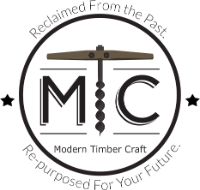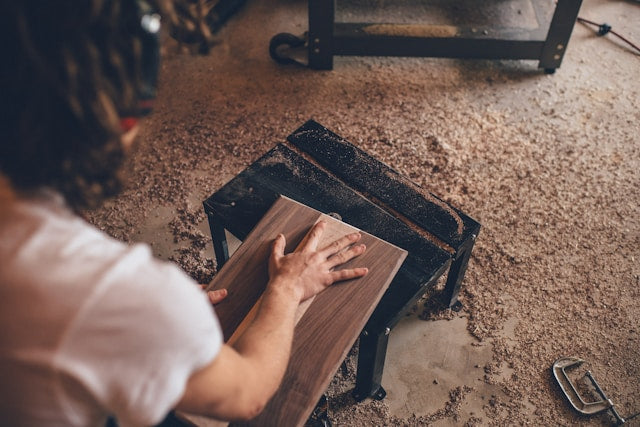RIncorporating reclaimed barn wood into modern homes is one of the biggest trends of 2020. As part of this growing trend, preserving reclaimed wood is a popular topic. Reclaimed wood can be used for flooring, cabinets, walls, furniture, and more, but only if it’s properly prepared and maintained. Unfortunately, most traditional wood finishing products and procedures aren’t a good fit for reclaimed wood, so homeowners and high-end contractors that want to jump on board with this trend need to do their research. Read on to get started.
The Problem with Traditional Wood Finishes
Part of the appeal of reclaimed barn wood is that it develops a beautiful gray patina over time. Traditional wood varnishes, oils, and waxes darken the wood, altering its appearance. Both water- and oil-based varnishes are designed to penetrate the wood fibers and produce more earthy tones.
Another solution for preserving reclaimed wood are waxes. Traditional waxes have an amber tint that’s great for new wood but causes reclaimed wood to lose its desirable gray patina. These products are best avoided if homeowners want to protect their investments.

A Better Solution
Now that they understand why traditional varnishes, oils, and waxes can’t be used for preserving reclaimed wood, some homeowners may be tempted to just leave a piece as-is instead of finishing it. That’s not a great option, though, since reclaimed wood usually contains pollen, insect pests, and micro-organisms that can be damaging to both the wood and the health of the home’s inhabitants if left intact. Reclaimed barn wood still needs to be finished, it just requires a slightly different process.
Clean the Wood
There are two ways to clean reclaimed barn wood without destroying its unique visual appeal. Homeowners can either use a dry brush to remove splinters, pollen, and pests or they can use a nylon brush and a small amount of soapy water. Either way, this step will require some serious scrubbing.
Never use sandpaper or mechanical sanders to clean up reclaimed barn wood. While dry or wet brushing will only get rid of splinters, dirt, and unwanted pests, sanding the wood down will completely destroy its beautiful patina and the aged layer of material so many desire. Some homeowners use 100 grit sandpaper to soften the surface lightly to prepare it for finishing, but those who want to go this route should tread lightly. Too much pressure can destroy the wood’s unique, vintage appearance.
Use the Right Wax
Traditional wood waxes alter the color of barn wood, so choose a product that’s specifically designed for finishing reclaimed wood. Renaissance Wax is a good option since it’s completely colorless and does not penetrate wood fibers.
Those who used soap and water to clean their barn wood should give it plenty of time to dry before applying the specialized wax to avoid sealing in moisture. Place them out in the sun for a few hours, but don’t leave them out for too long. This can cause the boards to bow and curl.
When applying wax, use a brush with short, natural bristles. Some homeowners use cotton rags instead, which is a viable option, but this technique can create complications due to the comparatively rough surface of reclaimed barn wood. Paintbrushes can be inexpensive, so just pick one up while purchasing wax.
Apply the wax in a thin, even coat. Keep in mind that a little bit goes a long way. The entire surface of the wood should be covered, but homeowners should stick to applying a single layer of wax at a time and shouldn’t go overboard.
Polish the Wax
Once the wax has dried, it will be completely clear. The surface is now ready to be polished to a full gloss. Polishing the wax will both improve the wood’s appearance, without affecting its patina, and make it easier to clean since it won’t be ruined by fingerprints.
Maintaining Reclaimed Barn Wood
Waxing and polishing the wood should help it maintain its longevity, but homeowners will still need to put some minimal time and effort into keeping it looking its best. Maintenance tasks can be divided into two categories: preventative maintenance and restoration. Thankfully, both of them are quite easy.
Preventative Maintenance
The amount of preventative maintenance a barn wood piece requires depends on how it is used. Walls and floors can simply be cleaned periodically with a damp rag or a mop, protected from spills, and otherwise left to their own devices. They may require more frequent restoration than barn wood furniture, but they should hold up fine to normal amounts of wear and tear.
Preventative maintenance for barn wood furniture requires a little more legwork. Homeowners should keep their furniture away from direct sunlight and heating or cooling vents. UV light causes discoloration, while frequent temperature and humidity changes can cause the wood to split, shrink, or dry.
Use trivets under hot items placed on reclaimed wood tables, and place coasters under drink cups. This will help homeowners avoid heat and moisture damage. Those who live in exceptionally humid or arid climates may also want to purchase humidifiers or dehumidifiers to control water vapor, but that’s a good idea even if homeowners don’t have reclaimed barn wood furniture.

Periodic Restoration
Restoring reclaimed barn wood floors, walls, and furniture is easy. Just apply a new coat of specialized wax every five years, or pay attention to the polish on the surface and reapply wax as needed. Floors and frequently used furniture like dining room tables or coffee tables need to be refinished more often than walls and furnishings like chairs or decorative pieces.
The Bottom Line on Preserving Reclaimed Wood
Building with reclaimed barn wood is a great way to add visual appeal to both traditional and modern homes. It takes a little extra work, but it will pay off in the long run as family and friends appreciate the unique patina and rustic beauty created by reclaimed wood surfaces and furniture. As long as they follow the advice above, most homeowners can clean, finish, touch up, maintain, and restore their own pieces using reclaimed wood sourced from nearby farms, homesteads, and other rural locations. All that’s left now is to source the wood and get started building.

Written by Jake Park
Jake is the founder of Modern Timber Craft and is a seasoned reclaimed woodworking enthusiast with over 20 years experience.


